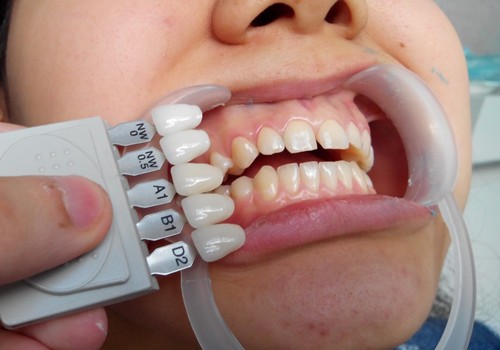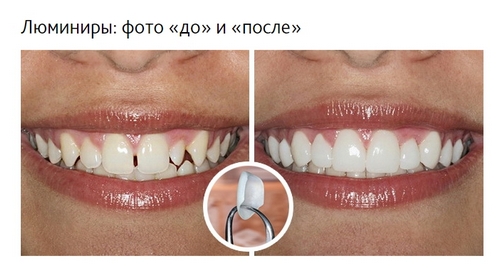Veneers – orthopedic plates for the restoration of the outer enamel surface. At its core is a very thin, non-removable teeth made of ceramic or composite material. Acting as a veneer, they are completely invisible to others and do not cause discomfort to its owner. Their teeth give a beautiful shape and natural color.
Veneers impose a direct and indirect way. In the first case, for the micro-prosthetics will require 1 visit to the dentist, during which a specialist will cause the composite material to the surface of the damaged tooth.
And the indirect method involves the manufacture of ceramic veneers on the individual print and installation of the plate on the tooth, which will require 2 visits to the dentist.
Lumineers is also veneers, only super thin. Patented by the American company Cerinate technology involves the production of plates of high-strength, slightly transparent ceramics that mimic the effect of a Hollywood smile. Original Lumineers is produced only in the laboratory Cerinate for their installation will require time and 2 visits to the specialist.
It is interesting to know! An alternative to veneers and Lumineers steel ultrasoni – thin plastics of the German E. max pressed ceramics. The result of their emergence is the attempt of Russian specialists to improve and veneers to create the equivalent of the American Lumineers. Ultramini made in the laboratory of St. Petersburg, they will require less time and occurs indirectly in 2 visits to the dentist.
The pros and cons of overlays
Veneers and Lumineers in demand in modern dentistry. In this case, both plates have their advantages and disadvantages.

Advantages of veneers
- Biocompatibility with the human body.
- High speed of manufacture, particularly composite veneers.
- Good strength, especially porcelain veneers.
- Aesthetically attractive, natural appearance.
- Reliable masking defects of the tooth.
- The pads retain their original characteristics during the entire period of use.
Cons of veneers
- The necessity of turning the hard tissues of the tooth.

The advantages of Lumineers
- Biocompatibility.
- High strength.
- Improved aesthetics – the “Hollywood smile“.
- Turning hard tissues of the tooth is not required.
- Records retain their original characteristics during the entire period of use.
Cons of Lumineers
- Because of their translucency of the plate camouflage colored (spotted) enamel.
- Installation without turning can make the tooth more prominent.
- Long production and delivery from America.
- High cost.
It is important to know! In order to make the right choice and to determine the feasibility of installing veneers or Lumineers, it is better to consult a dentist.
What is the difference between veneers and Lumineers
Thickness is the main difference to the pads. The average thickness of the veneer is 0.5 – 0.7 mm, and luminera – 0.2 – 0.3 mm. that is why before installing the veneer is required to dissect the hard tissue of the tooth, which makes the procedure irreversible because enamel cannot be restored. And in the case of installing Lumineers is minimally invasive, since turning is not required.
What is more expensive?
Lumineers are much more expensive compared to veneers. The high cost is simple – the micro-dentures are made overseas and transported by air.
What is better veneers or Lumineers
To understand what better, let us compare characteristics of veneers and Lumineers by the table.
|
Feature |
Veneers |
Lumineers |
| Thickness | 0.5 – 0.7 mm | 0.2 – 0.3 mm |
| Lifetime | Composite – 3 – 5 years, ceramic – 10 years or more | 20 years or more |
| The necessity of turning | Yes | no |
| Pain | Painful, is performed under anesthesia | Maloboleznennye when high sensitivity is applied anesthesia |
| The production time | Composite is 1 day, ceramic – 7 – 14 days | 1 – 2 months or more |
| Price is for 1 tooth | Composite – about 5000 rubles, ceramics – 20,000 rubles | About 35,000 rubles |
Thus, to answer the question, what is better, definitely not. In each case it is necessary to study the nature of defects of the tooth, especially the enamel and overall condition of the oral cavity.
It is important to know! Installation of veneers is an irreversible process, so procedures need to be serious evidence. The application of Lumineers is less traumatic and can be used purely according to the customer, for example, to create a Hollywood smile.
Indications for the installation of linings
The main indications for the installation of veneers or Lumineers are the following pathology of the anterior teeth.
- The presence of three or diastema (gap).
- Ugly tooth.
- Different amount of teeth.
- Wedge-shaped defect.
- Mechanical damage to the enamel is cracked and chipped.
- Darkening of the tooth enamel.
- Hypersensitivity, intractable to treatment.
Important! Chewing teeth are heavily loaded, veneers and Lumineers are installed.
Contraindications
Microprosthesis plates is not carried out in the presence of the following contraindications.
- Increased abrasion of teeth.
- Bruxism.
- Extreme lifestyle – Boxing and other traumatic sports that can damage the plates.
- Malocclusion.
- Periodontal disease.
- Strong curvature of the front teeth.
- The lack of a large number of posterior teeth.
- The presence of caries or severe damage to the prosthetic tooth.
Important! Before installing veneers or Lumineers, you must remove soft and hard plaque, Tartar and plaque smoker. Teeth are used only after a thorough cleansing of the tooth enamel. Otherwise, under the plate can progress to a pathological process of its destruction.
Care rules
After the installation of veneers or Lumineers, observe the following recommendations.
- Regular oral hygiene – morning and evening.
- Cleaning, rinsing the mouth or chewing gum without sugar after each meal.
- Avoiding harmful habits that may damage the plate – razgryzaniya solid food, gaping silence, etc.
Important! To trim lasts as long as possible and has not lost its initial appeal, it is necessary to take care to avoid injuries, bumps and drops that fall on the area of the teeth. Don’t abuse the aggressive food – too cold, hot, rich in acids and dyes. And regular checkups with your dentist – at least 1 – 2 times a year.




I really loved this article! It gave me some new insights I never really thought about before.